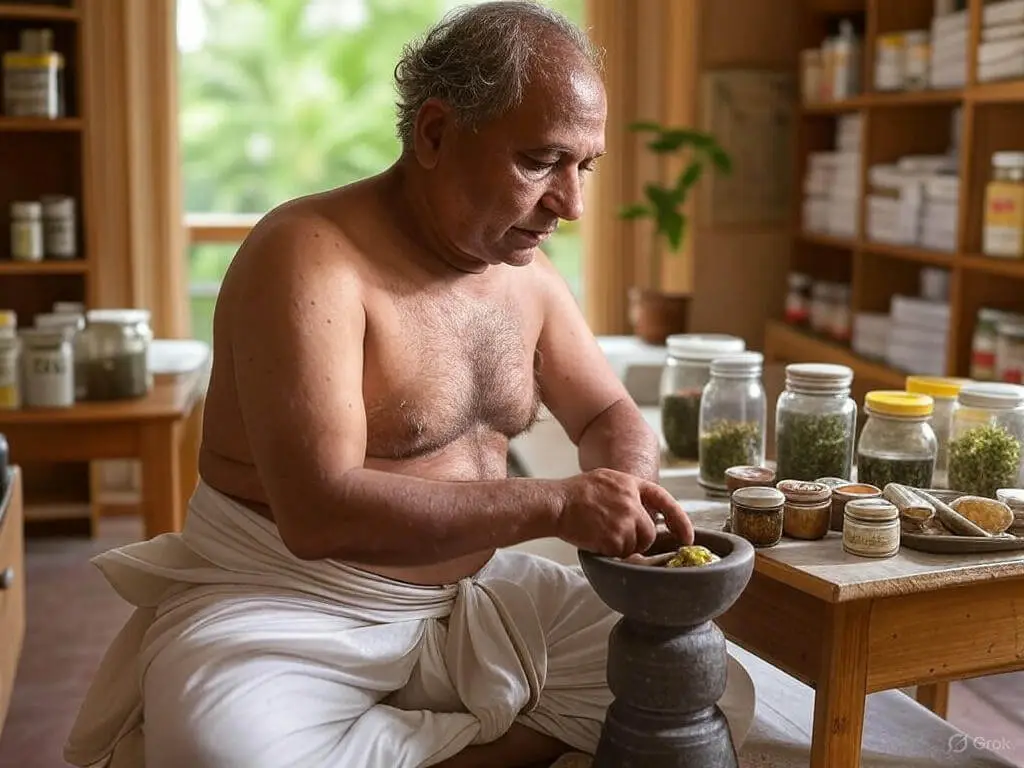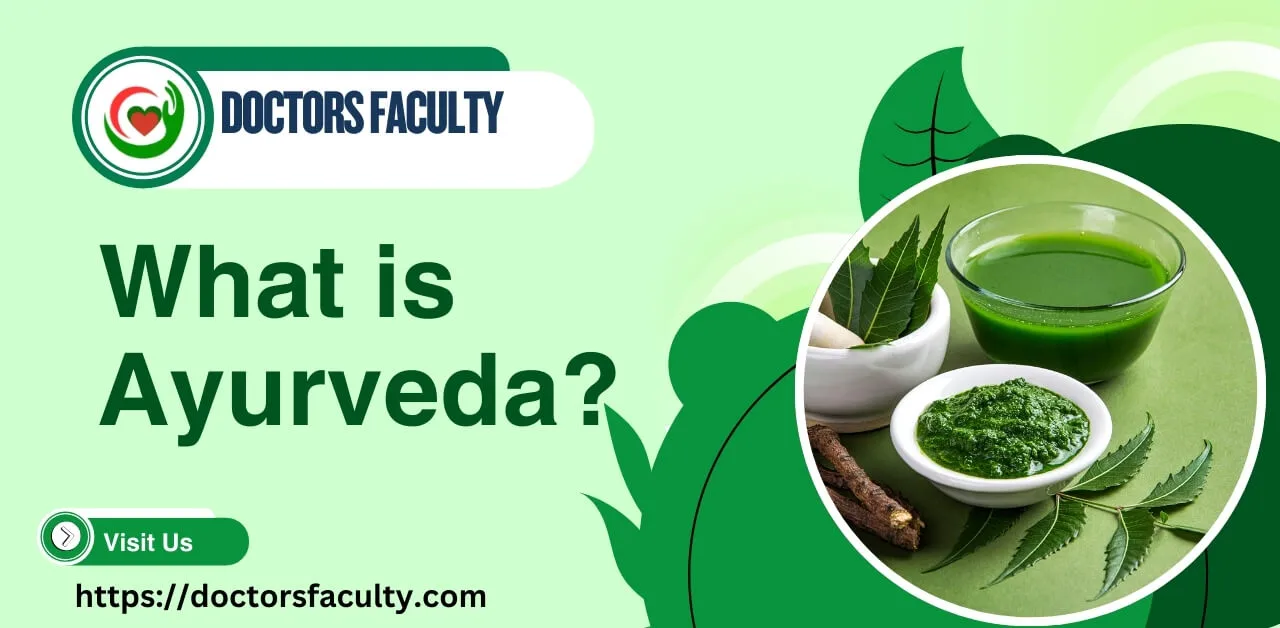What is Ayurveda, if not the coolest ancient secret, popping up everywhere lately? Ayurveda, a super old idea from India, is all about feeling great without spending tons of money. It’s a holistic approach with fancy words for fixing your whole self.
Ever think your mom’s soup made you better? That’s like Ayurveda!
In an era where people are increasingly interested to natural health solutions, the ancient wisdom of Ayurveda shines as a beacon of holistic wellness. This time-tested system, rooted in balance and harmony, has captivated modern health seekers eager to embrace alternatives to conventional medicine. With its promise of prevention over cure, Ayurveda offers a refreshing approach to well-being that resonates with those looking to sidestep disease and the soaring costs of healthcare.
This article is your fun guide to Ayurveda: what it is, where it came from, and how it helps today. It’s perfect if you want to skip colds and big doctor bills. I tried some Ayurveda stuff once, like a warm drink with herbs, and wow, it fixed my cough fast!
At DoctorsFaculty, we’re a team that helps you stay well with easy, natural remedies. Ayurveda is our favorite because it stops sickness before it starts—no pricey medicine is needed!
After completely reading this article, you will learn about Ayurveda’s rich history, philosophical foundations, and everyday practices that bring it to life. We’ll even examine how it differs from regular doctor advice. Want to feel good the natural way? Let’s go!
What is Ayurveda? The Basics Explained

What is the Definition of Ayurveda?
Ayurveda is an old way of healing from India that’s been around for thousands of years. The word “Ayurveda” comes from two Sanskrit words: “Ayur,” which means life, and “Veda,” which means knowledge. So, it’s like the “science of life.” It’s all about keeping people healthy using stuff from nature. A big health group says it started over 5,000 years ago (Learn more here).
The Holistic Approach
Ayurveda isn’t just about fixing you when you’re sick. It looks at your whole self, like your body, mind, and feelings. Instead of only treating a cough or a sore tummy, it uses natural things like plants, food, and exercise to keep everything working together happily. Scientists who study it say it’s special because it focuses on staying healthy, not just fighting sickness (Sharma, H., Journal of Alternative and Complementary Medicine, 2011, DOI:10.1089/acm.2010.0305).
What is the Core Philosophy Behind Ayurveda?
The big idea in Ayurveda is that your mind, body, and spirit need to get along. It comes from super old Indian teachings called Vedic medicine. Think of it like a team: the whole team struggles if one part is out of whack. Ayurveda helps them stay in harmony, like friends who help each other out. This idea goes back to ancient books from India called the Vedas, which are full of smart healing tips.
Ayurveda for Beginners
If you’re new to Ayurveda, don’t worry! It’s not hard to understand! It says your health is like a seesaw with energies that must stay balanced. When they’re even, you feel good. When they’re not, you might feel yucky. It’s a simple idea that anyone can try, even if you’re starting! People who teach Ayurveda say it’s perfect for beginners because it’s all about small, easy changes.
The History and Origins of Ayurveda

Ayurveda originated in India during the vedic period over 5,000 years ago when wise people wrote down big ideas about life and health. Two super old books, the Charaka Samhita and Sushruta Samhita, are like instruction manuals for Ayurveda. They discuss herbs, surgeries, and how to stay healthy. Experts at places like the National Center for Complementary and Integrative Health say these texts are some of the oldest medical guides in the world (Learn more here).
Over time, Ayurveda grew into a full medical system in India. Doctors and healers passed it down, tweaking it to help people with various problems. Later, it traveled beyond India—reaching places like the United States in the 20th century when folks got curious about natural healing.
Today, it’s taught in schools and used by wellness experts everywhere. A cool article from the Journal of Ayurveda and Integrative Medicine explains how it’s still growing and mixing with modern ideas (Check it out).
Ayurveda isn’t just about fixing your body. It’s tied to Indian traditions that also care about your mind and spirit. Back in the Vedic days, it grew alongside yoga and meditation, all part of a big plan to feel good inside and out. It says your mental health and spiritual peace are as important as not having a cold. That’s why it’s more than medicine; it’s a way of living connected to nature and yourself.
Even though it’s very old, Ayurveda fits right into today’s world. People love it because it’s about preventing sickness with simple, natural remedies—not just popping pills when you’re already sick.
At DoctorsFaculty, we’re big fans of this timeless system. Our mission is to bring natural ways to prevent disease for everyone, showing how its old tricks can tackle modern problems like stress or junk food diets. It’s like a bridge between ancient wisdom and what we need now for affordable and natural health.
Ayurvedic Principles: How Does Ayurveda Work?
What is Ayurveda without its cool rules? Ayurveda believes everything in the world, including you, is made of five basic elements: earth, water, air, fire, and space.
These aren’t just outside in nature but also inside your body. They mix to create your unique “constitution,” called Prakriti in Sanskrit. Think of it like your personal health blueprint.
What is Doshas? (Vata, Pitta, Kapha)

Three energies, or doshas, shape your Prakriti: Vata, Pitta, and Kapha. Each one comes from a combination of those five elements. Vata is air and space. It’s all about movement, like your breathing or energy. Pitta is fire and water; think digestion and heat. Kapha is earth and water. It keeps things solid and calm, like your bones or chill vibes. When these doshas get out of whack, you might feel tired, grumpy, or sick.
Experts say keeping them balanced is key to staying healthy (Chopra, A., Journal of Ayurveda and Integrative Medicine, 2010, Check it out).
How to Balance Between Mind and Body
So, how are your doshas off?
Ayurvedic healers use a cool trick called Nadi Pariksha, or pulse diagnosis. They feel your wrist to “read” your pulse, not just how fast it beats, but what it says about your energy. It’s like a secret code telling them if Vata, Pitta, or Kapha is too high or low. This helps them figure out what’s messing with their mind or body so they can fix it with food, herbs, or lifestyle tweaks.
What are the Key Practices in Ayurveda
Ayurvedic Lifestyle (Dinacharya)
Ayurveda loves a good daily routine called Dinacharya. It’s like a playbook for staying healthy. You wake up early to catch the calm morning vibes, scrape your tongue with a little tool to get rid of gunk, and try oil pulling—swishing oil in your mouth to keep your teeth and gums happy. These simple habits help your whole body feel good. Experts say it’s all about syncing with nature’s rhythm (Learn more here).
Ayurvedic Diet Table: Personalized Nutrition by Dosha
You eat what keeps you balanced based on your dosha (Vata, Pitta, or Kapha). It’s food just for you, based on your doshas—vata, pitta, kapha. No one-size-fits-all here! Think fresh veggies and spices, not pricey pills. My buddy swapped junk food for this and feels like a superhero now—no doctor bills needed.
| Dosha | Key Elements | Food Qualities | Best Foods | Foods to Avoid | Why It Works | Research Support |
|---|---|---|---|---|---|---|
| Vata | Air + Space | Warm, moist, grounding | Warm soups (e.g., lentil or veggie stew), cooked grains (oats, rice), root veggies (sweet potatoes, carrots), healthy fats (ghee, olive oil), warm milk with spices (cinnamon, nutmeg) | Cold, dry foods (e.g., raw salads, crackers), bitter greens, icy drinks | Vata needs warmth and moisture to calm its airy, restless nature. These foods settle energy and digestion. | Studies suggest warm, nutrient-dense diets aid digestion and energy (Kulkarni, P.H., 2012, See here). |
| Pitta | Fire + Water | Cool, light, soothing | Cooling fruits (e.g., melons, pears, grapes), sweet veggies (cucumber, zucchini), grains (barley, basmati rice), dairy (milk, ghee), mint or fennel tea | Spicy foods (e.g., chili peppers), sour fruits (citrus), fried or oily stuff | Pitta’s fiery vibe needs cooling foods to chill out heat, anger, or inflammation. | Cooling diets may reduce inflammation, aligning with Pitta balance (NCBI Review). |
| Kapha | Earth + Water | Light, warm, stimulating | Spicy dishes (e.g., ginger stir-fry), light grains (quinoa, millet), bitter greens (kale, arugula), warm teas (ginger, cinnamon), legumes (lentils, chickpeas) | Heavy, sweet foods (e.g., cakes, cheese), cold drinks, starchy roots (potatoes) | Kapha’s slow, heavy energy perks up with light, spicy foods to boost metabolism and avoid sluggishness. | Research shows low-calorie, spicy diets can support metabolism, key for Kapha (NCBI Study). |
Herbal Treatments
Ayurveda uses plants like superheroes. Take Ashwagandha—it’s a stress-buster that boosts energy. Turmeric fights inflammation with its golden power, and Triphala keeps your tummy in check. These herbs are safe, natural ways to strengthen immunity or handle chronic stuff like aches or colds. Scientists have studied them and say they work (See more).
Panchakarma (Detoxification)

Panchakarma is Ayurveda’s deep-clean mode. It’s a way to flush out toxins without weird chemicals. One part, Snehana, uses warm oil massages to loosen up the bad stuff inside you. Then, other steps, like steam or special drinks—sweep it away. It’s like hitting reset on your body, all naturally. Healers swear by it for feeling fresh and light.
Yoga and Ayurveda
Yoga and Ayurveda are best buddies. Yoga’s stretches and poses make your body strong and flexible, while Ayurveda keeps your mind calm and your doshas happy. Together, they’re a power team. Yoga fixes the outside, and Ayurveda tunes up the inside. Studies back this up, showing yoga boosts mental health too (Find out how).
Meditation in Ayurveda
Meditation is huge in Ayurveda for chilling out. It’s not just sitting quietly; it’s also training your brain to ditch stress and find peace. This keeps your emotions steady and your doshas in line. Ayurveda says a calm mind means a healthy body, and science agrees it lowers anxiety (Read more).
Ayurvedic Massage (Abhyanga)
Abhyanga is a warm oil massage you can do yourself or get from a pro. You rub special oils, like sesame or coconut, into your skin to get your blood flowing and your muscles relaxed. It’s like a hug for your whole body. Ayurveda fans say it’s a top way to feel good, and some studies hint it helps circulation, too.
Benefits of Ayurveda: Why It Matters

Natural Health Solutions
Ayurveda is about fixing your health with nature’s help; there is no need for expensive pills. It tackles stress with calming herbs like Ashwagandha, boosts immunity with stuff like turmeric, and even helps manage chronic problems like joint pain or tiredness. You don’t have to break the bank to feel better. A big health group says many people are turning to these natural tricks because they work without the high costs of regular medicine (Learn more here).
Preventive Healthcare
Ayurveda doesn’t wait for you to get sick. It stops trouble before it starts. Think of it like keeping your car tuned up so it doesn’t break down. The right diet, habits, and herbs keep your body strong and balanced. That’s exactly what DoctorsFaculty is all about—helping you stay healthy the natural way so you don’t need emergency fixes later. It’s proactive, not reactive, saving you time and money.
Natural Wellness
Ayurveda isn’t just about your body; It Also lifts your mind and emotions. It uses yoga, meditation, and smart eating to make you feel good.
Physically, you might sleep better or have more energy. Mentally, you’re calmer and less stressed. Emotionally, you feel more balanced and happy. It’s like a full-body tune-up that covers everything, not just one part.
Scientific Studies on Ayurveda
Science is starting to catch up with what Ayurveda has been saying for ages. For example, studies show that turmeric curcumin can fight inflammation, perfect for sore joints or a cranky gut.
Other research hints that Ashwagandha lowers and boosboostsergy (Check it out). But here’s the catch: not all Ayurveda has big, fancy studies yet. Some parts still need more proof, even though people swear by them. Still, what’s out there looks promising!
Ayurveda vs. Western Medicine: A Comparison
Imagine two toolboxes for fixing your health; one’s packed with ancient herbs and big-picture wisdom, and the other’s loaded with high-tech drugs and laser-focused solutions. That’s Ayurveda versus Western medicine in a nutshell.
People are buzzing about this showdown because it’s not just about choosing sides. It’s about figuring out what works best for you.
With its 5,000-year-old roots, Ayurveda promises natural balance, while Western medicine, the modern champ, tackles problems head-on with science.
In this comparison, we’ll explain how they differ, from their game plans to their go-to fixes and risks. Plus, we’ll see how DoctorsFaculty can team up to keep you healthy without draining your wallet.
Ready to dive in? Let’s compare these two heavyweights!
Comparison Chart: Ayurveda vs. Western Medicine
| Aspect | Ayurveda | Western Medicine |
| Approach | Holistic and integrative—looks at your whole self (body, mind, spirit) to keep you balanced and prevent sickness. Uses diet, lifestyle, and herbs to stop problems before they start. Experts call it a wellness-first system. | Symptom-focused—zeroes in on what’s wrong (like a cough or fever) and fixes it fast. It’s great for emergencies but often skips the “why” behind the issue. Known for reacting to illness rather than preventing it. |
| Goal | Long-term balance and prevention. Aims to keep your doshas (Vata, Pitta, Kapha) in harmony so you stay healthy naturally. | Short-term relief and cure. Targets specific diseases or symptoms with quick, powerful treatments; think surgery or antibiotics for a bad infection. |
| Treatments | Natural goodies like herbs (turmeric, Ashwagandha), oils, and yoga. Gentle on your body, low-cost, and backed by studies—like Ashwagandha reducing stress. | Synthetic drugs, surgeries, and tech (e.g., ibuprofen, X-rays). Fast and strong, but can come with side effects like nausea or high bills. Made in labs, not nature. |
| Diagnosis | Pulse checks (Nadi Pariksha), tongue exams, and questions about your life to spot dosha imbalances. It’s personal and hands-on, no fancy machines needed. | Blood tests, scans (MRIs, CTs), and lab work. Super precise with numbers and images, but might miss the bigger lifestyle picture. |
| Cost | Usually cheaper—herbs and lifestyle tweaks don’t need a big budget. DoctorsFaculty pushes this as an affordable way to stay well. | Can get pricey—think doctor visits, prescriptions, or hospital stays. Insurance helps, but it’s still a lot more than a jar of turmeric. |
| Safety Concerns | Mostly safe when done right, but watch out for unregulated stuff. Some pills had lead or mercury—about 20% in one study. Quality control is key! | Safe when prescribed properly, but risks include side effects (e.g., stomach issues from painkillers) or drug interactions. Heavily regulated by the FDA. |
| Speed of Results | Slower—builds health over time with steady habits. Great for chronic stuff like stress or digestion, less for emergencies. | Fast—knocks out acute problems like infections or broken bones quickly. Not always built for long-term prevention. |
| Strengths | Prevents illness, boosts overall wellness, and uses nature’s toolbox. Perfect for long-haul health without breaking the bank. | Excels at emergencies (heart attacks, surgeries) and pinpointing diseases with cutting-edge tools. Saved millions of lives with modern breakthroughs. |
| Weaknesses | Lacks big studies for everything—some benefits need more proof. Not ideal for urgent fixes like a car accident. | Ignores prevention sometimes and can over-rely on drugs. Side effects and costs pile up if you’re not careful. |
| Integration Potential | Can team up with Western medicine—like using Ayurveda to stay strong after a Western treatment. Studies hint at a combo future (Check this out). | Works with Ayurveda by handling acute needs while Ayurveda keeps you balanced long-term. Growing interest in this mix in the U.S. |
How to Start Ayurveda: Practical Steps for Beginners
Ready to try Ayurveda? It’s easier than you think! This ancient system is all about natural health, and you don’t need to be an expert to get going. These steps will kick things off if you want less stress, better energy, or to feel good without pricey meds.
Let’s walk through how to dive in safely and simply: start by figuring out who you are, trying some cool tricks, finding the right help, and leaning on DoctorsFaculty for guidance.
Understanding Ayurveda
First things first: get to know your Prakriti, or body constitution. It’s like your personal health ID—showing if you’re more Vata (airy), Pitta (fiery), or Kapha (earthy). You can take a simple quiz online—tons of free ones are out there, like from the Chopra Center (Try this)—or chat with an Ayurvedic pro for a deeper look. Knowing your Prakriti tells you what foods and habits fit you best. It’s your starting line!
How to Practice Ayurveda?
You don’t need to change everything to try Ayurveda; take tiny steps! Here are some super ways to start feeling awesome the natural way. Check out these simple tricks to wake up your body and mind:
- Sprinkle in Some Turmeric: Add this golden spice to your food, like in soup or on veggies. It’s an Ayurvedic herb that fights inflammation (keeps you less achy). It tastes good and helps your body like a win-win!
- Start Your Day Early: Wake up when the sun rises because early vibes are the best. It’s part of a cool routine called Dinacharya that gets you going. You’ll feel fresh and ready for anything.
- Splash Your Face: Toss cold water on your face right after waking up. It’s a quick zap to wake your skin and eyes—super simple! It also keeps you feeling clean and perky.
- Scrape Your Tongue: Use a spoon or a cheap tongue scraper to clean off the gunk. It’s an Ayurveda trick to kick out morning yuck from your mouth. It improves your breath and tummy.
These little moves are all it takes to start—your body and mind will love it the natural way. So easy, right?
Consult with Ayurvedic Practitioners
Want expert help? Look for certified Ayurvedic practitioners.
Not sure where to turn? DoctorsFaculty has your back. We’re all about safe, natural Ayurvedic solutions that won’t cost a fortune. Whether it’s tips on herbs, a starter routine, or finding clean products, we’re here to make Ayurveda work for you. We aim to help you confidently tap into this ancient wisdom—no guesswork, just real health you can trust.
Is Ayurveda Effective? Addressing Doubts
Ayurveda sounds awesome, but does it work? Let’s dig into the facts, the risks, and why it’s different for everyone. Here’s what you need to know if you’re wondering whether this ancient stuff holds up today.
Science isn’t sold on Ayurveda yet, but some studies say yes, and some say “meh.”
Big research is still catching up, but there’s good news: tons of people swear by it, and doctors are starting to mix it with modern medicine. Think integrative with health, where natural tricks like turmeric or yoga accompany regular checkups.
A health group says more folks try and like it, even if not everything’s proven yet. So, it’s got fans, even if the lab coats are still figuring it out!
Safety Note
Here’s a heads-up: Ayurveda is usually safe, but not always. Some products, like pills or powders, might contain nasty stuff like lead, mercury, or arsenic if they’re not made right.
A study found that about 20% of online Ayurvedic goodies contained these metals (Check it out). Yikes! That’s why you’ve got to buy from trustworthy places, like certified suppliers or pros who test their stuff. Skip the sketchy deals, and you’re golden.
Is Ayurveda Backed By Scientific Research?
Ayurveda has been around forever, over 5,000 years. But does science give it a thumbs-up?
People love its natural vibe, but you might wonder if there’s real proof it works.
Let’s break down what studies say, where they’re at, and what’s still a mystery. Spoiler—it’s a mixed bag, but there’s some cool stuff to know!
What Scientific Studies Show
Science has peeked at Ayurveda, and some parts shine. Take turmeric. Its magic ingredient is curcumin, which fights inflammation and is backed by solid research.
Or Ashwagandha. We already saw studies in the comparison table that say it can chill out stress and boost energy. These wins show that Ayurveda’s herbs can hold their own in labs. A big health group even says parts of it, like yoga and herbs, are getting more love from science every day.
The Challenging Part
Not everything in Ayurveda has been studied extensively yet. What about doshas (Vata, Pitta, Kapha) or pulse checks (Nadi Pariksha)?
They’re harder to test with fancy machines. Scientists want huge trials, like with thousands of people to say, “Yep, it’s legit.”
But Ayurveda’s old-school ways don’t always fit that mold. Some researchers call it promising but say we need more data to be sure. So, it’s not a total “no,” just a “not yet” for some bits.
Why Does It Still Matter?
Even without all the science locked down, Ayurveda’s got a fan base for a reason. People feel better with its personalized tricks. For instance, you can eat warm soups if you’re Vata or cool off with fruits if you’re Pitta.
Small studies and many real-life stories back this up, even if the big proof is still cooking. Plus, it’s teaming up with modern medicine more—think doctors suggesting yoga with pills. That mix hints that science is warming up to Ayurveda step by step.
Bottom Lines
So, what’s Ayurveda all about? It’s a super old medical system that is over 5,000 years strong and can keep you healthy in a natural way. It’s holistic, meaning it looks at your whole self—body, mind, and spirit- and uses herbs, food, and balance to keep your Vata, Pitta, and Kapha energies in check. It’s all about staying well, not just fixing sickness.
Ready to give it a shot? DoctorsFaculty is here to help you jump in! Check out our resources—tips on herbs, easy routines, or finding safe stuff—to start feeling great without spending a ton. We’re all about affordable, preventive health that stops problems before they start. Explore with us and see how Ayurveda can fit into your life—your body will thank you!



